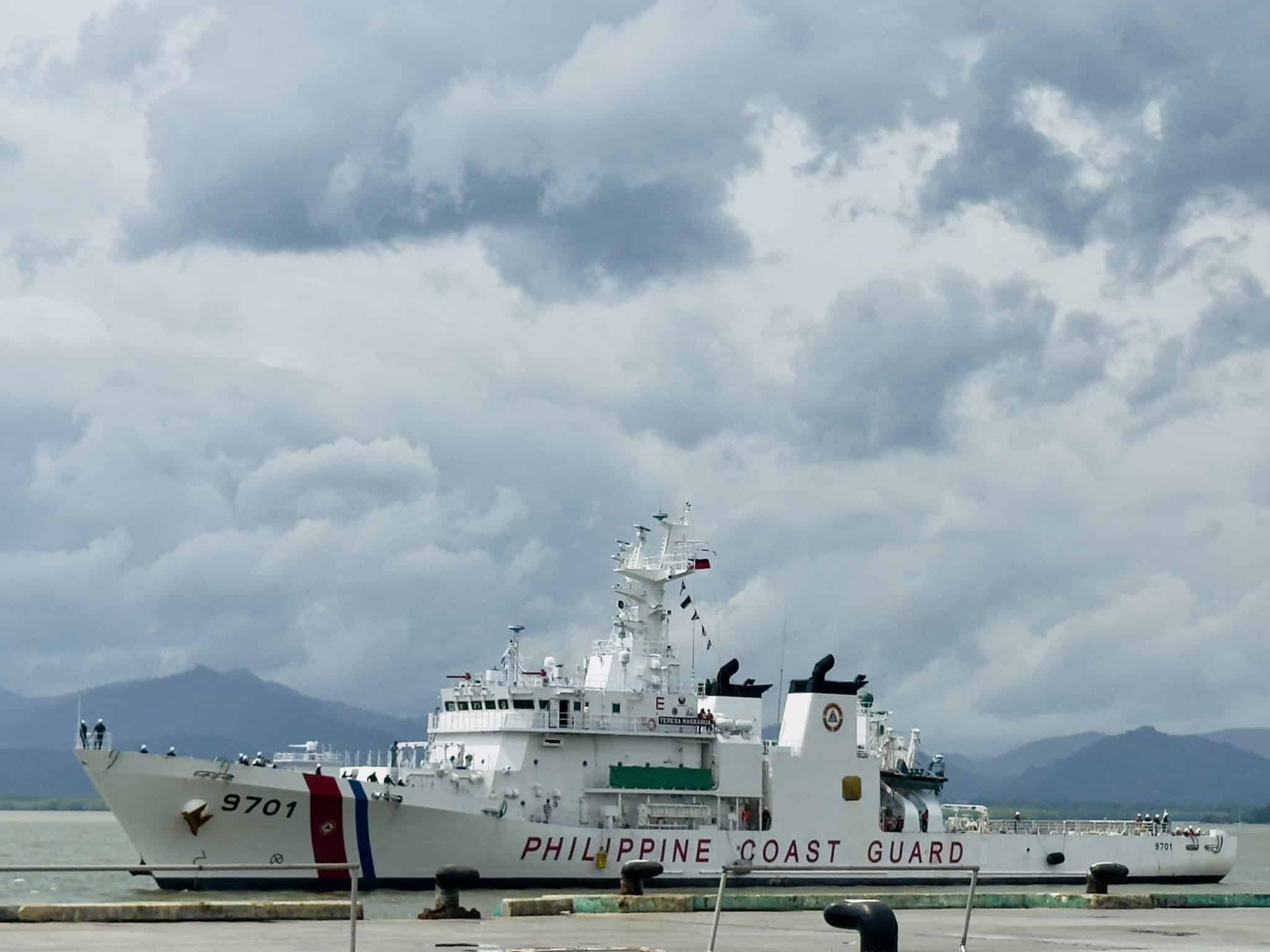
SAFE AT PORT After a five-month patrol at Escoda (Sabina) Shoal, the BRP Teresa Magbanua has returned to port at Puerto Princesa City in Palawan province. The Philippine Coast Guard (PCG) vessel, which was rammed by the Chinese during its deployment to Escoda, will undergo repairs. —PCG photo
MANILA, Philippines — The Philippine Coast Guard (PCG) on Monday said that it had not given up on Escoda (Sabina) Shoal despite pulling out its ship there after a record-setting five months of deployment.
Its offshore patrol vessel (OPV) BRP Teresa Magbanua returned to shore on Sunday after keeping watch on Escoda since April under the constant presence of Chinese vessels and suspected reclamation activities.
Escoda has emerged as a new flashpoint in the West Philippine Sea (WPS) following the confrontations between Manila and Beijing in recent weeks.
READ: PCG pulls out vessel from Escoda Shoal
“We have not lost anything. We did not abandon anything. Escoda Shoal is still part of our exclusive economic zone (EEZ),” PCG spokesperson Commodore Jay Tarriela said in a press conference.
The timing of the pullout came after top-level bilateral talks in Beijing last week where the Philippines asserted its position on Escoda and China demanded that the Magbanua be withdrawn.
But Tarriela said the decision to call Magbanua to port was not related to the discussions in Beijing and maintained that the PCG would still keep its presence in Escoda. He, however, did not provide details.
“We don’t have any guidance from the Department of Foreign Affairs for this kind of operational details. The decision of the commandant of PCG, Adm. Ronnie Gil Gavan, to pull out Magbanua is a decision that he made because of the welfare of the [crew], the seaworthiness of the vessel, and the most compelling factor is obviously the bad weather condition,” he pointed out.
Gavan earlier said he decided to bring the Magbanua home due to dwindling supplies, inclement weather, and crew members getting sick. Four personnel onboard the Magbanua suffered from dehydration due to a lack of proper drinking water.
Other options
Near the end of Magbanua’s mission, all the 63 crew members had to make do with rice porridge and go fishing for food. They also had to drink boiled rainwater for more than a month as the ship’s water filters for desalination had been overdue for replacement.
The National Maritime Council (NMC) on Monday also reiterated that another PCG vessel was on its way to Escoda Shoal to fill the void left by the pullout of Magbanua.
“As we speak, the PCG commandant has already issued a directive that, weather permitting, the designated vessel should have sailed out to Escoda Shoal,” NMC spokesperson Alexander Lopez told reporters.
Lopez said President Marcos directed the NMC to ensure that the Philippines maintains its presence at Escoda Shoal in the wake of concerns over the pullout of Magbanua.
“The directive of the President is for us to maintain our presence in the area,” he said, but added that this does not always have to be “physical presence.”
He again declined to discuss “operational details” of the deployment of a replacement ship and clarified that the Philippines’ presence at Escoda Shoal does not only entail sending a single vessel.
“When we say presence, strategic presence, not just physical presence. I just want to make clear that our presence is not limited to sending a single ship, that’s not it,” Lopez added.
“Sending a ship is just one of them, but we also have other technical capabilities to allow us to monitor and detect any illegal activities being conducted there, and if warranted, we will prevent these,” he said.
Navy deployment
Rommel Jude Ong, a retired rear admiral of the Navy and a professor of praxis at Ateneo School of Government, said the government should be willing to take more risks and learn the lessons from Magbanua’s mission.
“The recall of Magbanua was unfortunate, but there was no other choice. It has deployed inside the shoal beyond expectation and the limits of human endurance given the blockade thrown by China,” he told the Inquirer.
“We cannot fight China’s escalation dominance at sea with a risk-averse posture. China’s coercive tactics are designed to break our will and compel us to give up our interests, not only in Sabina Shoal, but in Second Thomas Shoal, Reed Bank, and other features. Unless we break this habit for the purpose of de-escalation, we will lose the West Philippine Sea by default,” he noted.
For one, the Philippines should acquire more large ships, such as the 97-meter Magbanua, only one of two in the PCG’s fleet, because it could withstand Chinese harassment and ramming.
According to Ong, the country has a better chance of sustaining control over the shoal if the PCG has more 97-meter offshore patrol vessels.
“But given the shortage of ships, the government might opt to lease or acquire civilian vessels and repurpose them as OPVs,” he said.
He added that the Philippines should also start deploying its coast guard in tandem with the navy, just as China does.
“We should debunk the ‘white versus white’ narrative that has constrained our options in the WPS. China has blatantly employed its navy in tandem with its coast guard and militia on several occasions already,” he said.
“If we lose control over the shoal, our situation in Second Thomas Shoal will be untenable. Moreover, it will be China’s deepest incursion into our waters, poised like a dagger against mainland Palawan,” he added.